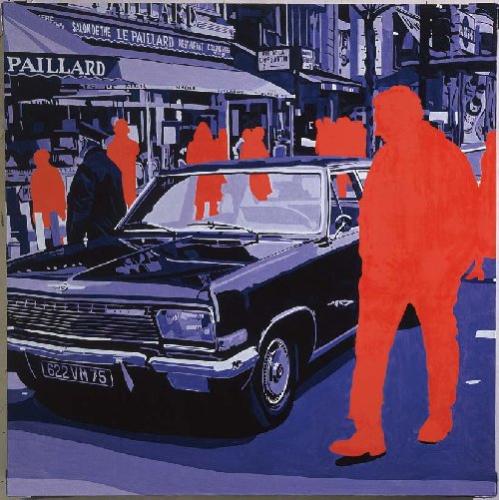La figuration narrative
dal 10/4/2002 al 1/6/2002
Segnalato da
10/4/2002
La figuration narrative
Hilger Contemporary, Wien
Here, artists like Adami, Arroyo, Erro', Fromanger, Kermarrec, Klasen, Monory, Poli, Rancillac, Rebeyrolle, Recalcati, Velickovic or Voss tested their figurative art.

Curator: Lóránd Hegyi
ERRÓ
FROMANGER
KLASEN
MONORY
RANCILLAC
..."Side by side with the activities of the Nouveaux Réalistes - characterized by Pierre Restany - which the public at large considered to be synonymous with European Pop Art for a certain time, there were other important groups in France. Their exhibitions demonstrated the most diverse tendencies of the new figurative art, marked by politics and sociology. As early as 1961 - one year after Nouveaux Réalisme was founded (as movement that became known very quickly) - artists such as Jacques Monory, Bernard Rancillac, Valerio Adami, Peter Klasen or Gerard Fromanger organized an exhibition in Paris - "Nouvelle Figuration". ... Bernard Rancillac, the artist and theorist, developed his aesthetic endeavors not only as a counter-trend to the lyric, informal abstractions, or the geometric, kinetic abstractions shown at art galleries in Paris during the fifties, but also as a discussion of society's realities. Here, artists were not only supposed to show the visible reality but also to interpret it critically and to go to its origins. In 1965, a large-scale exhibition "Narrative Figuration" was put together in Paris, comprising 68 artists. The titles of both exhibitions reflect clearly the return to figurative art, in other words to the artist's commitment to represent reality in a picture, and to define a theme like a narration, but also like a comment on society's realities" ...
..."Here, artists like Adami, Arroyo, Erró, Fromanger, Kermarrec, Klasen, Monory, Poli, Rancillac, Rebeyrolle, Recalcati, Velickovic or Voss tested their figurative art. They tried to state their figurative art as a kind of demystification, unveiling the manipulations - in images and pictures - of our modern consumer society, which gives legitimacy to the immediate interests of the power-holders - including, inter alia, the compulsion to consume, but also the different types of ideological repressions and irrational smoke-screening - by means of forceful pictures and by turning the "myths" of the modern capitalist consumer society into sensual and image-like objects."
... " The crisis of informal painting reinforced the interest of the young, figurative artists in a new, unbiased, impersonal, objective art that integrates the objects of everyday life and the fragments of everyday situations - such as advertisements, shop windows, newspapers and magazines, comics - without any aesthetic prejudices into an autonomous world of images. Erró, Peter Klasen, just like Richard Hamilton, the English Pop artist, who is their contemporary, tried from the very beginning to use in their pictures the themes of this new technical world, especially machines and constructions. Just like Jacques Monory and Eduardo Arroyo, the Parisian artists, they developed an increasingly transparent language of patterns that presented the visible world in a cool, impersonal manner - like a photograph or moving pictures. From the very beginning, it had a complex wealth of graphic references from the realm of trivial everyday life, from the modern, up-to-date, fashionable world of consumerism, from politics and contemporary history, but - at the same time - also from art history. While Arroyo, Monory, Klasen, Rancillac or Mimmo Rotella (at least for a time) very strongly and quite deliberately used photographs from daily newspapers, film reports, TV news or cinema posters, or pictures that the mass media had made known everywhere, Martial Raysse and Erró always also used fragments and easily recognizable details from art history to create their world of complex images." ...
..."The activities of the group Figuration Narrative were one of the most consistent statements in the artistic landscape of the sixties and seventies that followed a clear aesthetic and political logic. The references in their images put political, sociological, ideological realities into concrete terms, and it considered art, artistic activities, to be a subversive and - at the same time - analytical discussion at with the social, political, ideological and mental situation, with the power mechanisms, with the methods of manipulation. "
(Excerpts from: Lorand Hegyi, Figuration Narrative - Kritik des Bildnerischen in der spätmodernen Konsumgesellschaft (Comments on the Images in Late-Modern Consumer Society), in La Figuration Narrative, Vienna, 2002))
Image: Gerard Fromanger, Salon de thé, 1969
Inauguration: Thursday, 11 April 2002, 19.00 hrs.
The artists will attend the event.
The exhibition is open until 1 June 2002
Open Tues - Fri 10.00 -18.00 hrs., Sat 10.00 -16.00 hrs.
Ernst Hilger Gallery
Dorotheergasse 5
Vienna



